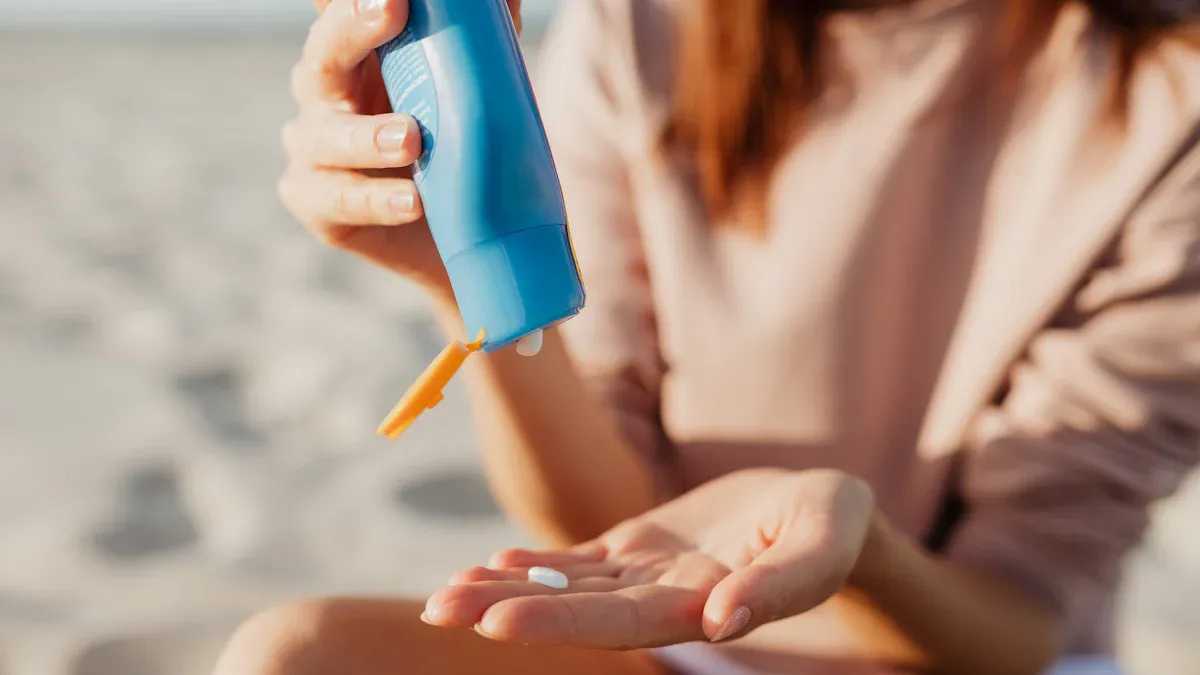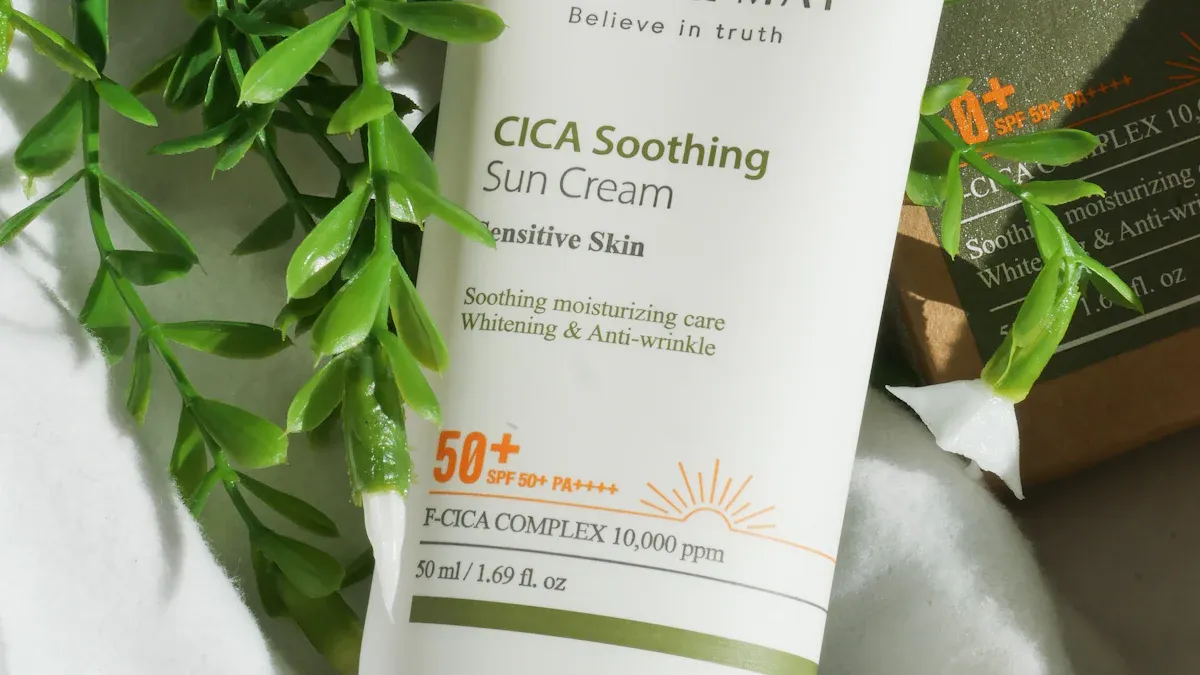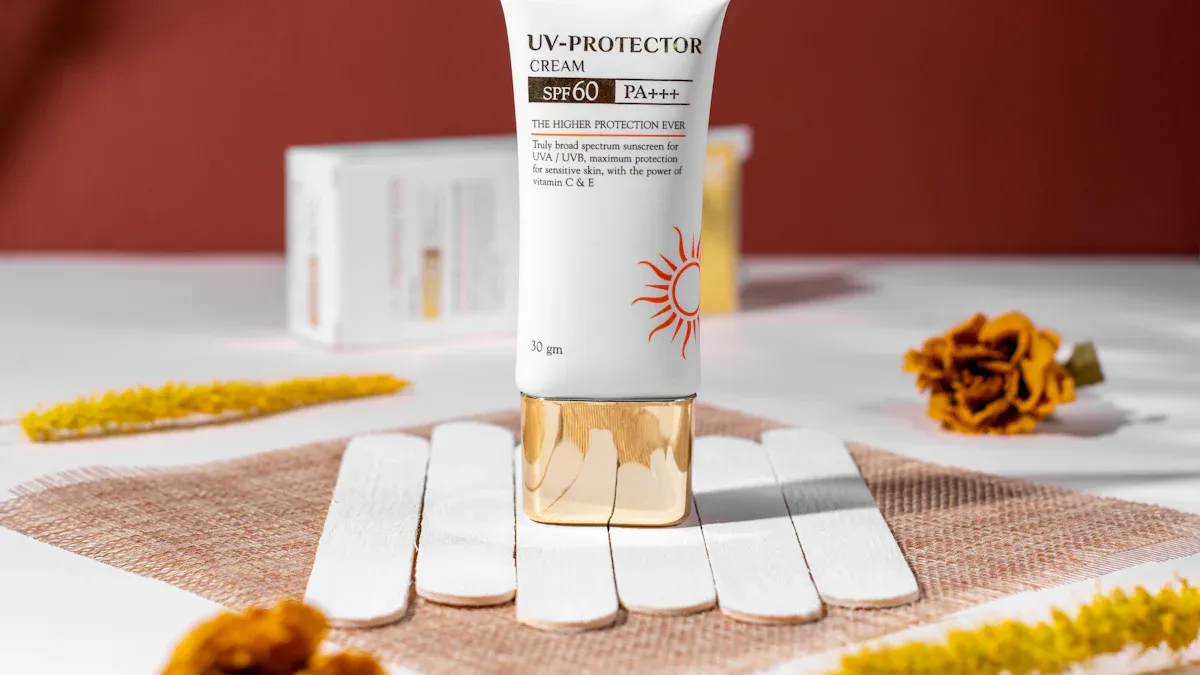
Если у вас чувствительная кожа, выбор правильного солнцезащитного крема становится решающим. Минеральные солнцезащитные кремы зачастую являются лучшим выбором, поскольку они остаются на поверхности кожи и снижают риск раздражения.. В отличие от химических солнцезащитных кремов, которые поглощают ультрафиолетовые лучи и могут выделять тепло, вызывающее дискомфорт., минеральные формулы отражают вредные лучи. Такие ингредиенты, как оксид цинка в минеральных солнцезащитных кремах, не только защищают, но и успокаивают кожу.. Это делает их идеальными для детей и людей, склонных к раздражению.. Понимание различий между Минеральный и химический солнцезащитный крем может помочь вам сделать лучший выбор для здоровья вашей кожи.
Ключевые различия между минеральным и химическим солнцезащитным кремом

Что такое минеральный солнцезащитный крем
Минеральный солнцезащитный крем, также известный как физический солнцезащитный крем, в качестве активных ингредиентов используются натуральные минералы, такие как оксид цинка и диоксид титана.. Эти минералы располагаются на поверхности вашей кожи и действуют как щит., отражая и рассеивая вредные ультрафиолетовые лучи. В отличие от химических солнцезащитных кремов, минеральные формулы с меньшей вероятностью раздражают чувствительную кожу.. Оксид цинка, например, не только блокирует лучи UVA и UVB, но также обладает антимикробными свойствами, которые помогают успокоить кожу.. Диоксид титана — еще один мягкий ингредиент, который эффективно защищает от солнечных лучей, не закупоривая поры..
Минеральные солнцезащитные кремы часто имеют более густую текстуру и могут оставлять на коже белый налет.. Однако, они начинают работать сразу после применения, что делает их удобным выбором для быстрой защиты от солнца..
Что такое химический солнцезащитный крем
Химический солнцезащитный крем содержит синтетические соединения, такие как авобензон., оксибензон, и октиноксат. Эти ингредиенты поглощают ультрафиолетовые лучи и преобразуют их в тепло., который затем высвобождается из вашей кожи. Химические солнцезащитные кремы легкие и их легко наносить., возможно, они не лучший вариант для чувствительной кожи.. Некоторые ингредиенты, например, оксибензон, может проникать через кожу и потенциально вызывать раздражение или аллергические реакции.
А 2019 Исследование выявило обеспокоенность по поводу того, что некоторые химические ингредиенты солнцезащитного крема всасываются в кровоток.. Хотя никаких доказанных рисков для здоровья с этим не связано., вызывает вопросы об их безопасности по сравнению с минеральными солнцезащитными кремами..
Как они работают
Минеральные и химические солнцезащитные кремы по-разному защищают вашу кожу.. Минеральный солнцезащитный крем отражает и рассеивает ультрафиолетовые лучи., создание физического барьера. В отличие, химический солнцезащитный крем поглощает ультрафиолетовые лучи и преобразует их в тепло.. Эта разница в механизме делает минеральный солнцезащитный крем лучшим выбором для чувствительной кожи., поскольку это позволяет избежать выделения тепла, которое может вызвать дискомфорт.
Активные ингредиенты и их эффекты
Активные ингредиенты минеральных и химических солнцезащитных кремов определяют, как они защищают вашу кожу и их общую безопасность.. Минеральные солнцезащитные кремы основаны на оксиде цинка и диоксиде титана., какие природные минералы. Эти ингредиенты остаются на поверхности вашей кожи., обеспечивает защиту широкого спектра, отражая лучи UVA и UVB..
FDA пришло к выводу, что два ингредиента можно считать безопасными — оксид цинка и диоксид титана., и два можно считать ибезопасный — ПАБК и салицилат троламина.. Обеспокоенность по поводу системной абсорбции солнцезащитных химикатов была подчеркнута недавним заявлением FDA о том, что ни один из солнцезащитных химикатов, используемых в настоящее время, не может считаться общепризнанным как безопасный..
Химические солнцезащитные кремы, с другой стороны, используйте синтетические соединения, такие как авобензон, оксибензон, и октиноксат. Эти ингредиенты поглощают ультрафиолетовые лучи и преобразуют их в тепло.. Хотя эффективен, некоторые из этих химикатов могут раздражать чувствительную кожу или вызывать аллергические реакции..
Исследования показывают, что оба оксид цинка и диоксид титана минимально впитываются в кожу.. Это снижает риск системных побочных эффектов.. Кроме того, аллергические реакции редки по сравнению с химическими солнцезащитными кремами., что делает их более безопасным выбором для долгосрочного использования..
Аспект | оксид цинка | Диоксид титана | Химические солнцезащитные кремы |
|---|---|---|---|
Тип защиты | Физический | Физический | Химическая |
УФ-защита | Широкий спектр (УФА & УФБ) | В первую очередь UVB | Переменная (зависит от ингредиентов) |
Риск раздражения кожи | Низкий | Низкий | От умеренного до высокого |
Воздействие на окружающую среду | Биоразлагаемый | Биоразлагаемый | Зависит от рецептуры |
Текстура, Приложение, и остаток
Текстура и способ применения солнцезащитного крема могут повлиять на ваш опыт и желание использовать его ежедневно.. Минеральные солнцезащитные кремы имеют более густую текстуру.. Они могут оставить белый налет на вашей коже., особенно если у тебя темный цвет лица. Однако, они реже закупоривают поры и подходят для кожи, склонной к акне..
Химические солнцезащитные кремы легкие и легко наносятся.. Обычно они высыхают прозрачными, что делает их популярным выбором для повседневного использования. Однако, им требуется около 20 минут, чтобы вступить в силу после применения.
В таблице ниже приведены основные различия между этими двумя типами.:
Особенность | Минеральный солнцезащитный крем | Химический солнцезащитный крем |
|---|---|---|
Активные ингредиенты | Оксид цинка, Диоксид титана | Авобензон, Оксибензон, Октиноксат |
Механизм действия | Отражает и рассеивает УФ-лучи. | Поглощает ультрафиолетовые лучи и преобразует их в тепло. |
Текстура приложения | Толще, может оставить белый налёт | Легкий, обычно прозрачный |
Немедленная эффективность | Начинает работать сразу | Потребности в 20 минут, чтобы быть эффективным |
Чувствительность кожи | В целом хорош для чувствительной кожи | Более высокий риск раздражения или аллергических реакций. |
Водонепроницаемость | Менее эффективен в воде. | Часто лучшая водостойкость |
Понимание этих различий может помочь вам выбрать солнцезащитный крем, соответствующий вашим потребностям..
Плюсы и минусы минерального солнцезащитного крема
Преимущества для чувствительной кожи
Минеральный солнцезащитный крем предлагает несколько преимуществ для чувствительной кожи.. Его активные ингредиенты, оксид цинка и диоксид титана, сидеть на поверхности твоей кожи, снижение риска раздражения или аллергических реакций. В отличие от химических солнцезащитных кремов, минеральные формулы не проникают в кожу и не выделяют тепла, что делает их идеальными для таких состояний, как экзема или розацеа..
Дерматологи рекомендуют минеральный солнцезащитный крем людям с чувствительной кожей из-за его нежного характера..
Он обеспечивает мгновенная защита от солнца, эффективно блокирует лучи UVA и UVB.
Некомедогенные свойства предотвратить закупорку пор, делает его подходящим для кожи, склонной к акне.
Доктор. Буллок подчеркивает, что детям часто отдают предпочтение минеральному солнцезащитному крему из-за его нехимического состава.. Это делает его более безопасным выбором для нежной кожи..
Экологические преимущества
Минеральный солнцезащитный крем полезен не только для вашей кожи.; это также лучше для планеты. В отличие от химических солнцезащитных кремов, которые содержат ингредиенты вреден для коралловых рифов, минеральные формулы биоразлагаемы и экологичны..
🌱 Исследования показывают, что солнцезащитные химические вещества, такие как оксибензон и октиноксат, способствуют обесцвечиванию кораллов и нарушают морские экосистемы.. Минеральные солнцезащитные кремы избегают этих вредных веществ., что делает их устойчивым выбором для защиты от солнца.
Экологические выгоды выходят за пределы океанов. Минеральный солнцезащитный крем представляет меньший риск для пресноводной среды., помогая сохранить водную жизнь. Выбирая минеральный солнцезащитный крем, вы вносите вклад в защиту чувствительных экосистем, сохраняя при этом свою кожу.
Недостатки, которые следует учитывать
Минеральный солнцезащитный крем имеет много преимуществ., не без минусов. Его более толстая текстура может затруднить нанесение., особенно если ты торопишься. Белый налет, который он оставляет на коже, может быть заметен., особенно на темных тонах кожи.
Некоторые пользователи находят минеральный солнцезащитный крем менее эстетичным из-за его физического блокирования..
Ограниченные исследования токсичности на людях поднимают вопросы о долгосрочной безопасности.
Определенные ингредиенты, как бензофенон-3, были отмечены как потенциальные нарушители эндокринной системы.
Несмотря на эти недостатки, минеральный солнцезащитный крем остается лучшим выбором для чувствительной кожи и потребителей, заботящихся об окружающей среде.. Его немедленная защита и нежная формула перевешивают незначительные неудобства для большинства пользователей..
Плюсы и минусы химического солнцезащитного крема
Преимущества для общего использования
Химический солнцезащитный крем имеет ряд преимуществ, особенно для повседневного использования. Его легкая текстура легко распределяется., не оставляя видимых следов. Это делает его популярным выбором для тех, кто предпочитает бесшовную отделку.. В отличие от минеральных солнцезащитных кремов, химические формулы часто обеспечивают лучшую водостойкость, что делает их идеальными для активного отдыха, например, плавания или занятий спортом..
Одним из наиболее существенных преимуществ является его защита широкого спектра. Химические солнцезащитные кремы защищают кожу от лучей UVA и UVB., что помогает предотвратить солнечные ожоги и снижает риск рака кожи. Нормативные стандарты, например, те, которые установлены FDA, убедиться, что эти продукты соответствуют строгим критериям безопасности и эффективности..
Тип доказательств | Описание |
|---|---|
Защита широкого спектра | Химические солнцезащитные кремы защищают как от UVA, так и от UVB-излучения.. |
Нормативные стандарты | FDA оценивает солнцезащитные кремы на эффективность и безопасность для потребителей. |
Сравнение с другими странами | Некоторые страны предлагают химические солнцезащитные кремы с лучшей защитой от UVA.. |
Эти особенности делают химический солнцезащитный крем удобным и эффективным вариантом для населения в целом..
Потенциальные проблемы для чувствительной кожи
Хотя химический солнцезащитный крем хорошо помогает многим, это может подойти не всем. Чувствительная кожа может реагировать на его активные ингредиенты., такие как оксибензон или авобензон. Эти химические вещества могут проникать через кожу., потенциально вызывает раздражение, покраснение, или аллергические реакции. Для людей с такими заболеваниями, как экзема или розацеа., это может ухудшить симптомы.
Тепло, выделяемое при поглощении ультрафиолетовых лучей химическим солнцезащитным кремом, также может вызвать дискомфорт.. Это делает его менее подходящим для людей, склонных к чувствительности к теплу.. Если у вас чувствительная кожа, рассмотрите возможность тестирования патчей перед регулярным использованием, чтобы избежать побочных реакций..
Экологические проблемы
Химический солнцезащитный крем представляет серьезную угрозу для окружающей среды. Вредные ингредиенты, такие как оксибензон и октиноксат, способствуют обесцвечиванию кораллов и нарушают морские экосистемы.. Исследования показывают, что 10% коралловых рифов мира находятся под угрозой исчезновения из-за этих химикатов. Кроме того, солнцезащитные химикаты загрязняют реки, озера, и океаны, влияющие на водную жизнь и качество воды.
Над 80% солнцезащитных кремов содержат вредные химические вещества, такие как оксибензон.
В мае 2018, На Гавайях запретили оксибензон и октиноксат в солнцезащитных кремах для защиты коралловых рифов.
В моче обнаружены солнцезащитные химикаты 97% протестированных лиц, вызывая обеспокоенность по поводу широкого распространения.
Тип доказательств | Описание |
|---|---|
Воздействие на морскую экосистему | Оксибензон и октиноксат наносят вред коралловым рифам и повышают токсичность прибрежных вод.. |
Риски для здоровья человека | Широкое распространение оксибензона вызывает потенциальные проблемы со здоровьем. |
Загрязнение воды | Химические вещества, защищающие от загара, ухудшают качество воды и наносят вред водной флоре и фауне.. |
Переходим на экологически чистые альтернативы, например, минеральные солнцезащитные кремы, может помочь уменьшить эти воздействия на окружающую среду.
Почему минеральный солнцезащитный крем рекомендуется для чувствительной кожи

Нераздражающие ингредиенты
Минеральный солнцезащитный крем является нежным средством для вашей кожи.. Его активные ингредиенты, оксид цинка и диоксид титана, сидеть на поверхности кожи, не проникая в нее. Это создает физический барьер, который защищает вас от вредных ультрафиолетовых лучей, не вызывая раздражения.. В отличие от химических солнцезащитных кремов, которые часто содержат синтетические соединения, минеральные формулы избегают агрессивных химикатов, которые могут вызвать дискомфорт.
Эксперты рекомендуют минеральные солнцезащитные кремы людям с чувствительной кожей или такими заболеваниями, как экзема., розацеа, и псориаз. Эти условия делают вашу кожу более реактивной к внешним факторам., поэтому крайне важно использовать солнцезащитный крем с нераздражающими ингредиентами.. Выбирая минеральный солнцезащитный крем, вы обеспечиваете эффективную защиту от солнца, сохраняя при этом кожу спокойной и здоровой.
Кончик: Ищите минеральные солнцезащитные кремы с маркировкой “широкий спектр” с SPF 30 или выше для защиты от лучей UVA и UVB..
Снижение риска аллергических реакций
Если у вас в анамнезе аллергия или чувствительная кожа, минеральный солнцезащитный крем – более безопасный выбор. Химические солнцезащитные кремы часто содержат такие ингредиенты, как оксибензон и ПАБК., которые, как известно, вызывают аллергические реакции. Эти соединения могут раздражать кожу., приводит к покраснению, зуд, или даже сыпь.
Минеральные солнцезащитные кремы, с другой стороны, полагаться на оксид цинка или диоксид титана. Эти природные минералы не содержат раздражающих органических соединений., что делает их идеальными для чувствительной кожи. Дерматологи часто рекомендуют минеральные солнцезащитные кремы людям, склонным к аллергии, поскольку они сводят к минимуму риск побочных реакций..
Химические солнцезащитные кремы могут проникнуть в кожу и вызвать раздражение..
Минеральные солнцезащитные кремы остаются на поверхности., снижение вероятности возникновения аллергических реакций.
Они особенно полезны для детей и людей с нежной кожей..
Выбирая минеральный солнцезащитный крем, вы защищаете свою кожу, не беспокоясь о нежелательных побочных эффектах.
Немедленная защита после применения
Одной из наиболее удобных особенностей минерального солнцезащитного крема является его немедленная эффективность. В отличие от химических солнцезащитных кремов, которые требуют около 20 минут на активацию, минеральные формулы начинают действовать сразу после их применения. Это делает их практичным выбором, когда вы спешите или вам нужна быстрая защита..
Физический барьер минерального солнцезащитного крема мгновенно отражает и рассеивает ультрафиолетовые лучи.. Это гарантирует, что ваша кожа будет защищена от вредного воздействия солнечных лучей без периода ожидания.. Собираетесь ли вы на пляж или выходите по быстрым делам, вы можете положиться на минеральный солнцезащитный крем для мгновенной защиты..
🌞 Вы знали? Минеральный солнцезащитный крем не только обеспечивает немедленную защиту, но и обеспечивает широкий спектр действия., защищая вас от лучей UVA и UVB.
Использование минерального солнцезащитного крема, вы упрощаете процедуру ухода за кожей, обеспечивая при этом безопасность вашей кожи под солнцем.
Практические советы по выбору и нанесению солнцезащитного крема
Как читать этикетки солнцезащитных кремов
Понимание этикеток солнцезащитных кремов поможет вам выбрать лучший солнцезащитный крем для ваших нужд.. Ищите фактор защиты от солнца (СПФ) рейтинг. СПФ 30 или выше обеспечивает адекватную защиту от UVB-лучей. Проверьте “широкий спектр” на этикетке. Это обеспечивает защиту как от UVA, так и от UVB-лучей., которые ответственны за старение кожи и солнечные ожоги.
Водонепроницаемость – еще одна важная особенность.. Солнцезащитные кремы с маркировкой “водостойкий” или “очень водостойкий” сохранять защиту SPF в течение определенного времени, находясь в воде. Если вы планируете плавать или потеть, выберите водостойкую формулу.
Для максимальной защиты, обильно нанесите солнцезащитный крем. Используйте два миллиграмма на квадратный сантиметр кожи.. А “правило двух пальцев” может помочь отмерить нужное количество. Нанесите солнцезащитный крем на все открытые участки, включая твое лицо, уши, шея, и оружие. Повторяйте каждые два часа или сразу после купания или вытирания полотенцем.
Патч-тестирование для чувствительной кожи
Тестирование патчей необходим для чувствительной кожи. Это помогает выявить потенциальные аллергены до полного применения.. Выполнение патч-теста, нанесите небольшое количество солнцезащитного крема на внутреннюю часть предплечья или за ухом.. Ждать 24 к 48 часы, чтобы проверить наличие покраснений, зуд, или раздражение.
Дерматологи рекомендуют проводить патч-тесты людям, склонным к аллергическому контактному дерматиту.. Стандартная серия аллергенов, как Североамериканская базовая серия, обнаружить распространенные аллергены. Для детей, серия Pediatric Baseline предлагает индивидуальное тестирование. Эти тесты помогают убедиться, что солнцезащитный крем безопасен для вашей кожи..
Если во время патч-теста вы испытываете раздражение, избегать использования продукта. Вместо, выбирайте минеральные солнцезащитные кремы с оксид цинка или диоксид титана. Эти ингредиенты нежны и подходят для чувствительной кожи..
Лучшие практики для ежедневного применения
Ежедневное использование солнцезащитного крема защищает кожу от вредных ультрафиолетовых лучей.. Наносите солнцезащитный крем даже в пасмурные дни, как до 80% УФ-лучи могут проникать через облака. Используйте полную унцию солнцезащитного крема для тела, размером примерно с мяч для гольфа. Для твоего лица, нанесите достаточно, чтобы покрыть его равномерно, не оставляя пробелов.
Повторно наносите солнцезащитный крем каждые два часа, чтобы сохранить его эффективность.. Если вы плаваете или потеете, подайте заявку повторно сразу после этого. Сочетайте солнцезащитный крем с защитной одеждой, например, длинные рукава и широкополые шляпы., для дополнительной безопасности.
Время имеет значение. UVB-лучи наиболее сильны между 10 являюсь. и 4 вечера, но лучи UVA могут причинять вред круглый год.. Постоянное использование солнцезащитного крема защищает вашу кожу от обоих типов лучей.. Для кожи, склонной к акне, выбирайте некомедогенные солнцезащитные кремы, чтобы предотвратить закупорку пор.. Минеральные солнцезащитные кремы часто являются лучшим вариантом солнцезащитного крема для чувствительной и склонной к прыщам кожи..
Рассматривая проверенных производителей, таких как Oully
При выборе солнцезащитного крема, качество продукта имеет такое же значение, как и его состав. Надежные производители, такие как Не убедиться, что ты в безопасности, эффективная, и высококачественные солнцезащитные кремы, адаптированные к вашим потребностям. Более чем десятилетний опыт работы в сфере красоты и ухода за собой., Oully стала надежным партнером для мировых брендов и предприятий..
🌟 Почему стоит доверять Оулли? Наше FDA-, Изо-, и сертифицированное cGMP предприятие гарантирует, что каждый продукт соответствует самым высоким стандартам безопасности и качества..
Oully специализируется на индивидуальных решениях, позволяя вам создавать солнцезащитные кремы, соответствующие вашим конкретным требованиям. Наш опыт в разработке индивидуальных рецептур гарантирует, что ваш солнцезащитный крем содержит лучшие ингредиенты для оптимальной защиты кожи..
Наша комплексная производственная поддержка упрощает этот процесс для вас.. От рецептуры до дизайна упаковки, Oully выполняет каждый шаг с точностью. Это гарантирует, что ваш солнцезащитный крем не только будет работать хорошо, но и будет выглядеть привлекательно для ваших клиентов..
💡 Кончик: Если вы ищете солнцезащитный крем под частной торговой маркой, Услуги прямой поставки Oully позволяют легко и быстро вывести ваш продукт на рынок..
Если вы ищете высококачественные солнцезащитные кремы, рассмотрите проверенных производителей, таких как Не. Их настраиваемые рецептуры и приверженность безопасности гарантируют, что вы получите продукты, отвечающие уникальным потребностям вашей кожи.. Выбирая правильный солнцезащитный крем, вы защищаете и свою кожу, и окружающую среду.
Часто задаваемые вопросы
Что значит “рифовый сейф” солнцезащитный крем значит?
Солнцезащитный крем, безопасный для рифов, не содержит вредных химических веществ, таких как оксибензон и октиноксат, которые повреждают коралловые рифы.. В нем используются экологически чистые ингредиенты, такие как оксид цинка или диоксид титана, которые защищают вашу кожу, сохраняя морские экосистемы.
Как часто следует наносить солнцезащитный крем для ежедневной защиты от солнца?
Наносите солнцезащитный крем каждые два часа в течение дня.. Повторно наносите после купания или потоотделения.. Ежедневная защита от солнца гарантирует, что ваша кожа останется в безопасности от вредных ультрафиолетовых лучей., Даже в облачные дни.
Минеральный солнцезащитный крем лучше для чувствительной кожи?
Да, минеральный солнцезащитный крем хорошо подходит для чувствительной кожи. Его ингредиенты, как оксид цинка, сидят на поверхности кожи и снижают риск раздражения. Обеспечивает немедленную защиту, не вызывая дискомфорта..
Можно ли пользоваться солнцезащитным кремом каждый день?
Да, ежедневное использование SPF необходимо для защиты кожи от ультрафиолетовых лучей.. Регулярное применение предотвращает солнечные ожоги., преждевременное старение, и повреждение кожи. Выбирайте солнцезащитный крем широкого спектра действия с SPF. 30 или выше для эффективной защиты.
Вредит ли солнцезащитный крем окружающей среде?
Некоторые химические солнцезащитные кремы вредят морской жизни и коралловым рифам. Солнцезащитные кремы, безопасные для рифов, не содержат этих химикатов., что делает их лучшим выбором для экологически сознательных потребителей.. Минеральные солнцезащитные кремы биоразлагаемы и более безопасны для водных экосистем..
















